A development boom is reshaping Eugene. Could this be the end of the city as we know it?
In 2010 Stuart Phillips and his wife, Emily, founded Red Wagon Creamery, a from-scratch ice cream maker. After a year of recipe development and “using our lucky neighbors as taste testers,” says Phillips, a wry smile behind his blond-and-white goatee, the couple in 2011 began selling their confections from a refurbished Häagen-Dazs pushcart they found on Craigslist. A year later, Red Wagon added a second cart — and tripled sales. By 2013 Red Wagon had opened a storefront on Broadway in downtown — and sales tripled again.
Today Phillips sees more crowds than the area has known in a generation. And in the redeveloped buildings along Broadway, he sees something else. “As Eugene grows out of the ‘60s, it’s becoming more overtly entrepreneurial.”
Long regarded as a college town and counterculture haven both, a new, decidedly pro-development vibe is emerging in Eugene, Oregon’s third largest metro area. The clearest sign so far? A mix of public and private investment has begun transforming downtown, an influx that began during the Great Recession and is continuing during the current real estate boom.
Now, instead of empty storefronts, dilapidated buildings and holes in the ground, over the last five years public and private sources have invested over $300 million in downtown real estate and business projects. Meanwhile Eugene is talking less about its alternative culture roots and more about fostering a bustling epicenter of tech and creative industries, surrounded by other small to midsize businesses specializing in retail, food, craft beer, and more. The wider metro area is also attracting larger companies such as Avago Technologies, Winnebago Industries and Firstsource.
In many ways, Eugene’s growth mirrors the trajectory taken by other Oregon cities like Bend and Portland. More than either of those metropolitan areas, however, Eugene is the poster child for Oregon’s left-leaning lifestyle. And as this burg of 159,358 tries to nurture more economic opportunity, it is also struggling to move beyond an entrenched belief that social and environmental responsibility and economic development are mutually exclusive.
It’s a debate that pits against one another entrepreneurs and traditional business leaders pushing to accelerate development on the one hand, and old-guard business owners and community activists hoping to put the brakes on growth on the other.
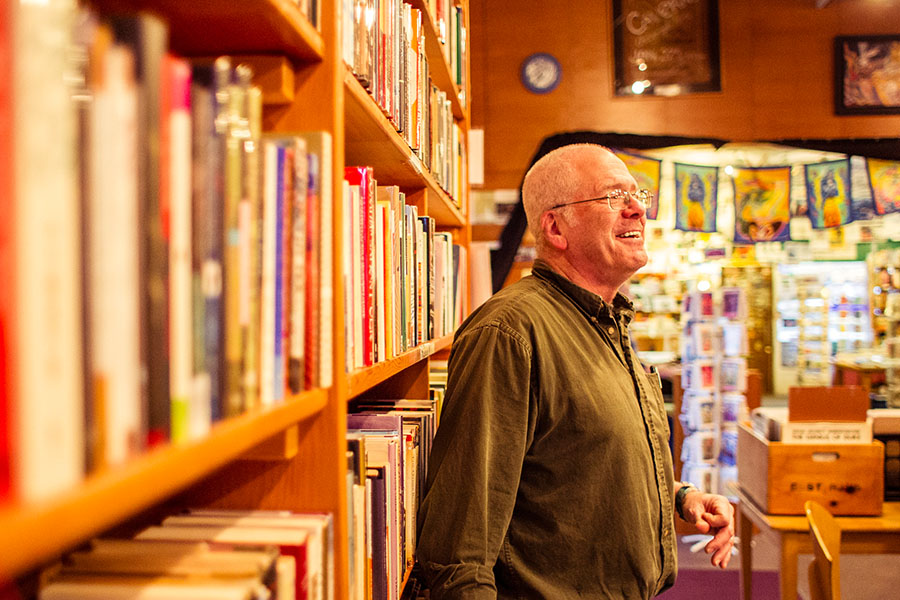
Scott Landfield, owner of Tsunami Books
Scott Landfield falls into the latter category.
“Fifteen years ago there were 25,000 less people, and football was not yet a citywide mania,” says Landfield, an irascible 62-year-old who for 19 years has run Tsunami Books, an independent book shop and event space on Willamette Street, a busy commercial and traffic corridor. Today, he says, “high-octane alcohol and marijuana, and brain-numbing football, are now in control of a huge percentage of the Eugene dollar. Whether intended or not, all this makes mindless development by money-hungry developers from all over the world a cakewalk. Money from all over the world is buying this town.”
Sabrina Parsons, CEO of Eugene-based Palo Alto Software, begs to differ. If anything, she says, the city needs to ramp up its effort to attract high-growth companies and to seed the kind of sophisticated retail and restaurant environment necessary to recruit and retain workers from bigger metropolitan areas.
“We need to keep new people coming in with creative, different ideas, innovating and building cool things, with a healthy respect for community involvement and Eugene’s history and past,” says Parsons, who recently relocated her software firm to the redeveloped Broadway Commerce Center downtown. “We can’t be afraid of change or new things. Isn’t that what the counterculture was originally all about?”
Founded in 1862 as a trading post, Eugene has never been quite as anti-business as some might think. The city has a long history of independent crafts businesses and, until the late ‘80s, sustained healthy manufacturing and timber sectors. But if the Eugene anti-capitalist hippie stereotype is that — a stereotype — today’s building spree has brought the city’s underlying tension between people and profit to the fore while also spotlighting the seemingly inexorable march of 21st-century market-oriented change.
Consider the Oregon Country Fair, founded in 1969. OCF continues today just west of Eugene with art, drum circles and outrageous costumes — but without the purported open alcohol and drug use of earlier years. In 2015, 52,333 people from all over the country attended OCF — breaking a 2009 record of 47,493. According to a 2009 economic impact analysis conducted by the University of Oregon, OCF generates approximately $3 million per day for the Lane County economy, comparable to the 2008 U.S. Olympic Track & Field Trials hosted in Eugene.
Ken Kesey — the author of “One Flew Over the Cuckoo’s Nest” and an influencer of the Grateful Dead — called Eugene home. In 1999, then-mayor Jim Torrey described the city as “the anarchist capital of the United States.”
It’s an odd contrast to the University of Oregon, an ivory tower that sometimes seems renowned less for academics and more for a football program that attracts ESPN broadcasts, athletic facility construction and significant funding from Nike founder Phil Knight. (As a recent local political cartoon quipped, you could fly over campus and catch a “rare glimpse” of an academic building.)
In 2011 activists set up a long-running Occupy Eugene camp and organized protests with as many as 2,000 participants. In 2008 Whole Foods proposed opening a downtown location, but local outcry caused the grocer to withdraw. In 2015 Whole Foods returned, with a store that is slated to open later this year.
Twenty years ago, businesses steered clear of Eugene’s Whiteaker district, a neighborhood noted for its radical politics and relatively high crime rate. Today Mayor Kitty Piercy and electric vehicle firm Arcimoto, among other notables, count the neighborhood as home, and the gentrified area has become a mecca for craft beer, nightlife and trendy dining.
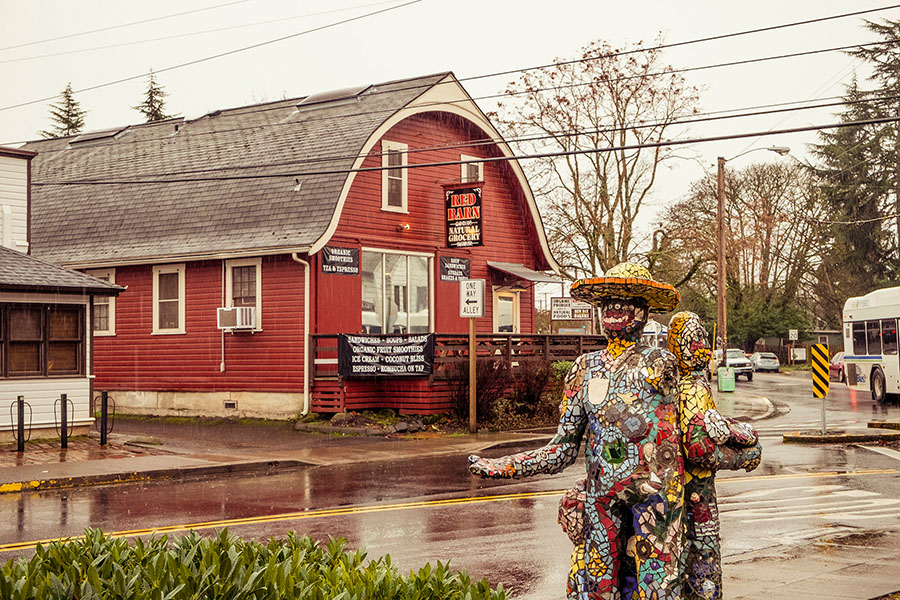
The Whiteaker area has become a city hot spot.
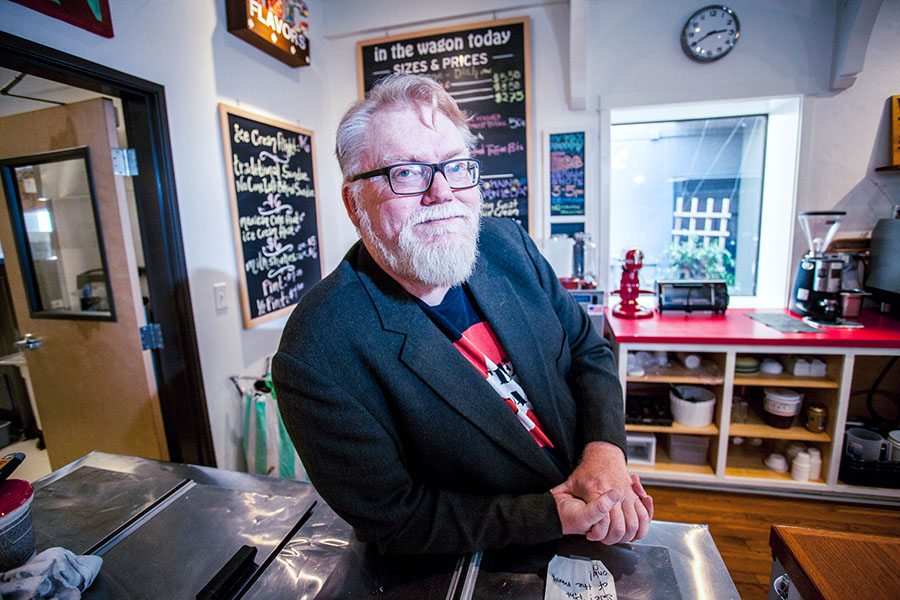
Stuart Phillips, co-founder of Red Wagon Creamery
Red Wagon restructured from an LLC to a “B corporation,” a socially responsibile business certification that gives the company “more flexibility in things like sourcing local produce without having to skin the farmer,” says Phillips. “That’s the counterculture of the 21st century: You don’t have to drop out to make things change. Running a cool business with high ethics is probably the sweetest revenge.”
Joe Maruschak also believes the city of Eugene could stand to sell itself a bit more; the city needs, he says, “a little bit of Portland for the economic development”—more hustle, more bustle and a more inviting atmosphere to bring in innovative people and organizations that want to live in a vibrant urban community.
That said, Maruschak, chief startup officer and director at RAIN Eugene (Regional Accelerator and Innovation Network), also counts the city’s history of political activism in a long list of positives about Eugene. “I’m a business guy who is pro-business, but I also don’t want Eugene to change. I like it here. I don’t want to live in Portland.”
Maruschak moved here from New Jersey in 1993 “for the mountain biking” and says he has come a long way from living in his van. “I don’t like when people fan the flames of class divide,” he observes. “Businesspeople don’t dislike hippies or counterculture. We just don’t like the way they’re doing things. Most of the rage seems to come from the counterculture.”
Sam Rutledge, a self-described citizen activist who works downtown, isn’t exactly full of rage. But he is concerned about what he describes as “a concerted push to make downtown less hospitable to homeless people in particular and poor people generally.”
Clad one day in a suit and bow tie and another in floral-print pants, Rutledge has been involved with community movements including Occupy Eugene, Kesey Square Revival and Save Kesey Square. “Eugene has a lot of zero-growth NIMBY naysayers, and I’m not one of them,” says Rutledge. But “if the business community can bring resources, our social service community can bring expertise. Together I think meaningful solutions that are humane and actually begin to address the problems faced by people on the street, rather than just moving them on to a different neighborhood, can be achieved. I want downtown to work for everyone.”
In 2015 Eugene’s median home price was $215,200; median household income is $45,159. Although the city has yet to see an affordability crisis on the scale of Bend and Portland, activists say the city needs to ensure housing and services for low-income residents and a burgeoning homeless population, which, according to the city, can be 3,000 people on any given day. Tsunami Books’ Landfield, for example, would like to see rent-controlled housing for families and others, “instead of just assuming it will be high-end condos, banks, and frou-frou shops.”
And student housing. It’s impossible to talk about economic growth and cultural change in Eugene without discussing the state’s flagship institution, which has embarked on its own building spree in recent years. New facilities include the Phil Knight-backed Matthew Knight Arena and PK Park — as well as the $95 million Erb Memorial Union.
The latter features national chains such as Starbucks and Chipotle, a third location for Eugene brewpub Falling Sky, and a second Eugene location for Portland-based Townshend’s Tea Company.
Off campus the university is also reshaping the city landscape and adding fuel to the debate over growth. A spate of new student-housing towers downtown, many developed by national companies, has triggered pushback from community members while spotlighting the funding challenges facing the university.
“Because state funding has declined, the university has been forced to attract more international students,” says University of Oregon sociology professor Michael Dreiling. “What you see is a housing boom around that has a lot of people wondering: Is it going too far? Is it pushing public spaces to the edge? Are we losing some of that cultural distinctiveness?”
Internally, the university is more in sync with the city goals, revamping curriculum to meet the needs of new business and building on the university’s history of spinning out biotech and other science startups.
“There’s something to be said for startup-driven economic growth,” says Andrew Nelson, an associate professor of management and the executive director for RAIN@UO, an affiliate of RAIN Eugene. The university has a strong relationship with area tech companies, Nelson says, although, he notes, “we also have room to improve. We’re working hard to increase our external partnerships with the community and the region.”
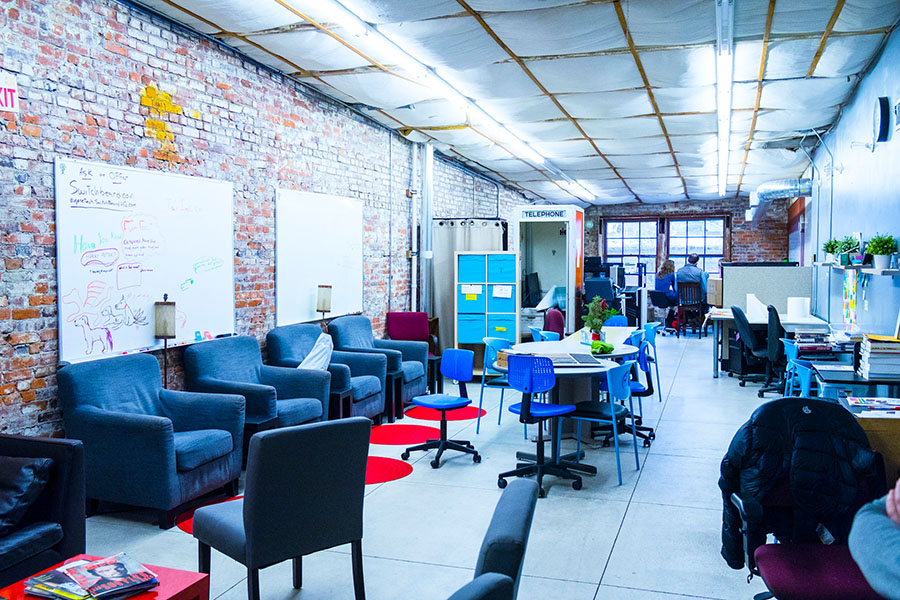
Fertilab Thinkubator, a co-working and mentorship space
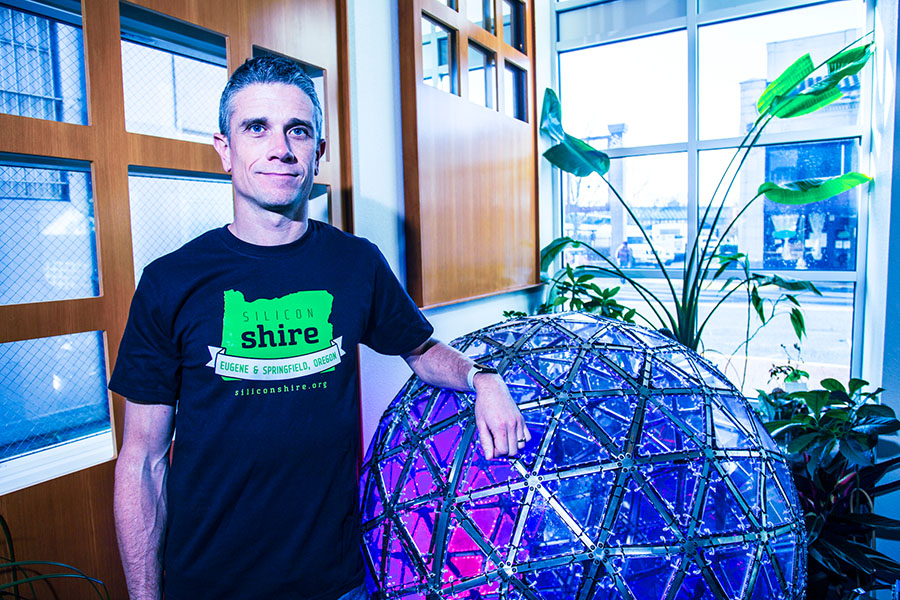
Concentric Sky president Cale Bruckner with a Radiance Orb crafted by startup Light at Play
As the university shores up its entrepreneurial resources, civic and business leaders are ramping up efforts to promote Eugene as a mecca for new technology companies, big and small. Cale Bruckner, the president of downtown software company Concentric Sky, is a prominent pitchman.
Frustrated that that Eugene lacked name recognition for local and national job seekers in the technology community, Bruckner came up with the idea of branding the city as “Silicon Shire.” His team also built an online directory as “a banner we could all rally underneath to promote our growing tech cluster, recruit talent and get out from underneath the shadow of Portland’s booming tech scene.”
Today SiliconShire.org lists 222 organizations, from hardware development to digital creative — plus craft beer. “It wasn’t that long ago that you’d be hard-pressed to find a 50-plus-person tech company in the area,” says Bruckner. “Now there are quite a few.”
One of the newcomers is Smarsh, a Portland-based digital archive firm that recently announced plans to open a Eugene location with a dozen employees. Just as San Francisco firms are migrating to Portland, Portland tech firms are now setting up satellite operations in smaller cities such as Eugene, often driven by lower operations and real estate costs, along with proximity to fresh talent graduating from area universities.
Fellow tech leader Sabrina Parsons would like to harness the intellectual capital of Eugene’s tech community, the University of Oregon and Oregon State University to become a powerhouse research triangle similar to the public/private/university partnership in North Carolina. Whether that can happen in a grim funding environment for Oregon universities is up for debate.There are other limitations. Economic prosperity in Eugene hinges on wage increases to attract workers to tech and other burgeoning industries, Parsons and others say. “While our affordability is great, it can be hard for companies if the virtual workforce puts on salary pressure and starts making Eugene companies pay Bay Area salaries,” Parsons says. Maruschak agrees: “We try to sell the idea that you move here for nature and lower cost of living, but it just winds up coming across as trying to sell a pay cut that needs to go away,” he says.
By 2030 Eugene’s population is expected to almost double to 213,000, according to the nonprofit Envision Eugene. To help accommodate new growth, the city is proposing a massive upzoning of South Eugene neighborhoods, known as the “South Willamette Special Area Zone,” or SW-SAZ, a controversial project that could create as many as 3,400 new residential units.
Meanwhile, downtown development continues. Campbell Commercial Real Estate recently purchased the eight-story Eugene Professional Building, built in 1926 as Eugene’s first high-rise. The firm plans a sweeping renovation to attract professional firms and tech companies. Despite opposition from conservative group Our Money, Our Transit, a bus rapid-transit line operates between Eugene and Springfield, and it continues to expand throughout major local corridors.
Last year the city announced, with much fanfare, that the IAAF World Championships for track and field would be held in Eugene. In previous years global cities such as Beijing, Berlin and Osaka have hosted the event.
Can Eugene continue down this path, attracting new businesses and boosting wages, all the while maintaining affordability, public space and a renowned independent, quirky character? Creating an inclusive mix of uses is the goal, says Denny Braud, who oversees the city planning economic prosperity, downtown, and affordable housing divisions.
Braud, his voice suffused with a calm optimism, was a key player in the revitalization of downtown, steering millions of dollars in urban-renewal funds to many of the mixed-use projects that have sprung up in recent years. He describes his role as burning both ends of the candle: transforming downtown into an “innovation district” that brings in both good jobs and affordable housing.
“We’re seeing industry focus that doesn’t divide the community,” he says. “That’s not always the case, but overall we’re finding that sweet spot where the community will embrace that because it’s local, natural, creative and artsy.”
In many ways, the sociocultural divide in Eugene mirrors the divide marking all metropolitan areas attracting development dollars and a coveted young, educated demographic. Income inequality, entrepreneurialism, high-density development: These hot-button issues are reshaping urban environments and sparking debates around the country. But the battle in Eugene seems at once sharper, more ideological, while also offering the possibility of collaboration and détente.
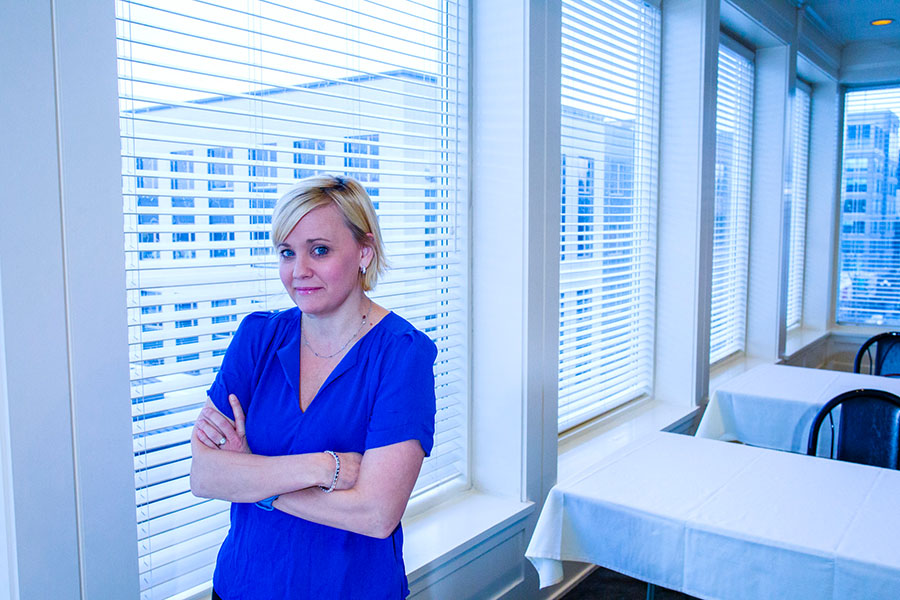
Sarah Bennett, principal of Bennett Management Company
But Bennett, who sits on the board of the Eugene Area Chamber of Commerce, tacitly acknowledges the upside of the current political balance. “There’s very little risk that Eugene will become anywhere near homogenized or lose its funky vibe.”
Anthony St. Clair is a freelance writer in Eugene.



